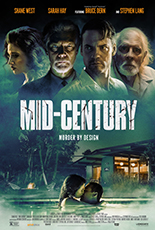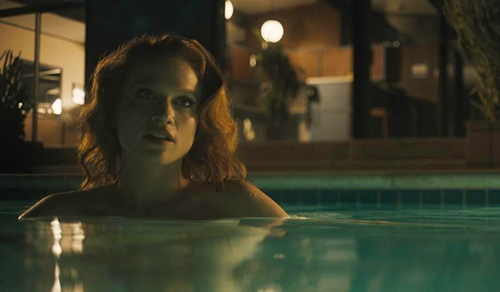
 I don’t like ghost movies in which someone says, “You look like you’ve seen a ghost.” The character may not be cognizant, but the movie sure as hell winks. Mid-Century is one of them.
I don’t like ghost movies in which someone says, “You look like you’ve seen a ghost.” The character may not be cognizant, but the movie sure as hell winks. Mid-Century is one of them.
Coinciding with a big eclipse, Alice (Chelsea Gilligan, Door to the Other Side) and Tom (Shane West, Escape the Field) rent a 1950s home for the weekend. She’s a surgeon interviewing for a hospital gig; he’s an architect who drops Andy Warhol quotes in his RFPs. And the house? It’s one of the first designed by architecture giant Frederick Banner (Stephen Lang, Don’t Breathe) — think, oh, Frank Lloyd Wright, but if Frank Lloyd Wright branched out from designing skyscrapers to also murder beautiful women.
Tom finds a book revealing Banner was a polygamist whose wife “disappeared” under mysterious circumstances. He was also deep into the occult via a secret society called The Brotherhood of the Orange King (you mean MAGA?), which sought to achieve immortality. Not long after, Tom starts receiving visits from a ghost of one’s Banner’s victims — lucky for him, a redheaded cutie-pie one (Sarah Hay, The Mortuary Collection).
And that’s merely the tip of the Eames chair. As a fan of mid-century modern architecture and its general aesthetic that seeped into the design of American culture at a time when “copasetic” lived free in our vernacular, I was primed for Mid-Century. Turns out, it’s a mess, but a fabulous-looking mess. The script by first-timer Mike Stern (who effectively plays Banner’s progeny) is overly complex, with too many characters straddling too many subplots amid too many time frames. It’s as if he gave his director (#1 Cheerleader Camp actress Sonja O’Hare) not merely a story, but a world-building bible.
It feels like three movies stuck together with tape — the kind people in movies tear with their teeth — and it would even if we discounted the hallucinatory cameo by the great Bruce Dern, who utters a few sentences without having to stand. While West is not likely destined for film history, he deserves credit for always showing up with a committed intensity. By contrast, a vacancy exists behind Gilligan’s lines, some of which are cribbed from millennial memes: “Real talk,” “This is a mood,” et al. In that spirit, I’ll borrow an oft-used slang word from my teenage son: This tale of the supernatural is indeed “mid.” —Rod Lott

